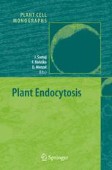Search
Filters applied:
Search Results
-
Endocytosis and Actomyosin Cytoskeleton
Mutual interactions between actin and endocytic assembly machineries are essential for successful clathrin-mediated endocytosis in yeast and...
-
Endocytosis and Membrane Recycling in Pollen Tubes
In plants, tip-growing cells are an ideal system to investigate signal transduction mechanisms and, among these, pollen tubes are one of the...
-
Toxicity and Preliminary Risk Assessment of Alternative Antifouling Biocides to Aquatic Organisms
Published literature has been reviewed regarding the toxicity of representative alternative antifouling biocides (Chlorothalonil, Dichlofluanid,...
-
Plant Prevacuolar Compartments and Endocytosis
Prevacuolar compartments (PVCs) are membrane-bound organelles mediating protein traffic from both Golgi and plasma membrane to vacuoles in...
-
Importance of Cytoskeleton and Cell Wall in Somatic Embryogenesis
Both the cytoskeleton composed of microtubules and actin microfilaments as well as cell wall components such as arabinogalactan proteins and...
-
Ions and Pollen Tube Growth
Ions play a crucial role in the control of pollen tube growth. In this review we focus on four that seem especially important: calcium (Ca...
-
Comparative Analysis of Biological Models used in the Study of Pollen Tube Growth
The mechanisms of pollen tube growth have been studied in a wide variety of plant species. Since the 1990s, with the explosion of molecular...
-
Gametic Embryogenesis in Triticum: a Study of Some Critical Factors in Haploid (Microspore) Embryogenesis
This review of embryogenesis from microspores in two types of wheat examines the influences of various procedures used to induce and produce...
-
Emergence of Complexity in Financial Networks
We present here a brief summary of the various possible applications of network theory in the field of finance. Since we want to characterize...
-
Characteristics of Biological Networks
Network principles describe uniformly systems as diverse as the cell or the Internet. The emergence of these networks is driven by self-organizing...
-
Course 13: Self-organized Criticality in Granular Superconductors
We study the critical state of a one-dimensional granular superconductor (multijunction SQUID with random arrangement of junctions) in an increasing...
-
The Endoplasmic Reticulum: A Central Player in Cell Signalling and Protein Synthesis
In addition to being the principle intracellular Ca 2+ store, the endoplasmic reticulum (ER) is the initial site of synthesis and folding of membrane...
-
Molecular responses of higher plants to dehydration
A massive amount of data has been accumulating on the molecular responses of plants to water deficit. In plants, dehydration activates a protective...
-
Heavy metal signalling in plants: linking cellular and organismic responses
Heavy metals are required in plants as essential micronutrients or act as toxic compounds. How do plants perceive heavy metals and which signalling...
-
Introduction
Everywhere in the world, environmental stresses represent the most limiting factors for agricultural productivity. Besides plant-specific endogenous...
-
Course 3: Structural Relaxation and Rheology of Soft Condensed Matter
These lectures address the relation between structural dynamics and macroscopic flow behaviour (rheology) in soft condensed matter. After a brief...
-
Course 8: Equilibrium States and Dynamics of Equilibration: General Issues and Open Questions
Equilibrium states and the dynamics of equilibration are reviewed with emphasis on general issues and open questions. Macroscopic systems with...
-
Global and Local Regulation of Neuronal Differentiation by Calcium Transients
Embryonic spinal neurons express ion channels prior to synaptogenesis that mediate specialized forms of excitability promoting Ca 2+ influx. Ca 2+...
-
Role of NAADP in Coordinating Spatiotemporal Aspects of Calcium Signalling
We outline the roles of two low molecular weight phosphorylated compounds as intracellular messengers in calcium signaling. These new intracellular...
-
Classes of the Shortest Pathway Structures in Scale Free Networks
We study a problem of data packet transport between a pair of vertices on scale-free network, and introduce load of a vertex as the accumulated sum...
